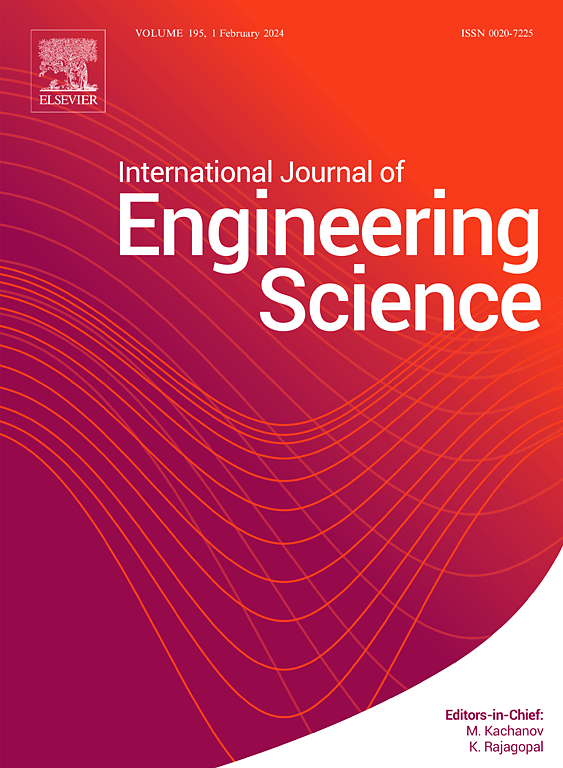导致应变梯度弹性的多胞均匀化渐近展开方法
IF 5.7
1区 工程技术
Q1 ENGINEERING, MULTIDISCIPLINARY
International Journal of Engineering Science
Pub Date : 2025-05-31
DOI:10.1016/j.ijengsci.2025.104318
引用次数: 0
摘要
应变梯度弹性理论将材料的固有长度参数纳入其本构关系,在工程科学中广泛应用于模拟固体和结构的尺寸相关力学行为。然而,无论是解析解还是有限元法、边界元法、有限差分法等数值方法,在求解过程中都经常遇到溢出现象等数值难题。在本文中,我们提出了一种渐近展开方法来解决由多单元均匀化产生的应变梯度弹性理论的边值问题。该方法允许将位移矢量和频率参数以级数形式展开,从而产生一系列新的边值问题,这些问题需要在材料固有长度参数的不同幂次下求解。利用新提出的边界条件、分部积分和作者引入的统一恒等式,导出了有序频率参数的解析解。给出了应变梯度杆和梁自由振动的两个例子,以证明在应变梯度弹性的渐近展开方法的理论框架内所建立的渐近表达式的有效性。可以预见,在本工作中建立的渐近展开方法可以作为应变梯度理论的有效计算工具,特别是在传统数值方法,如有限元方法,由于溢出问题而失败的情况下。本文章由计算机程序翻译,如有差异,请以英文原文为准。
An asymptotic expansion method for multi-cell homogenization leading to strain gradient elasticity
Strain gradient elasticity theory, which incorporates intrinsic material length parameters into its constitutive relationships, is extensively utilized in modeling size-dependent mechanical behaviors of solids and structures in the engineering science. However, numerical challenges such as overflow phenomena are frequently encountered during solution procedures, whether through analytical solutions or numerical methods like the finite element method, boundary element method, and finite difference method. In this paper, we propose an asymptotic expansion method for addressing boundary value problems associated with strain gradient elasticity theory produced by a multi-cell homogenization. This method allows for the expansion of the displacement vector and frequency parameter in series form, thereby generating a sequence of new boundary value problems to be solved at varying powers of the intrinsic material length parameters. Analytical solutions for ordered frequency parameters are derived using newly proposed boundary conditions, integration by parts, and a unified identity introduced by the present authors. Two examples illustrating free vibration of strain gradient rods and beams are provided to demonstrate the efficiency of the asymptotic expressions developed within the theoretical framework of the asymptotic expansion method for strain gradient elasticity. It is anticipated that the asymptotic expansion method established in this work can serve as an effective computational tool within strain gradient theory, particularly in scenarios where conventional numerical methods, such as the finite element method, fail due to overflow issues.
求助全文
通过发布文献求助,成功后即可免费获取论文全文。
去求助
来源期刊

International Journal of Engineering Science
工程技术-工程:综合
CiteScore
11.80
自引率
16.70%
发文量
86
审稿时长
45 days
期刊介绍:
The International Journal of Engineering Science is not limited to a specific aspect of science and engineering but is instead devoted to a wide range of subfields in the engineering sciences. While it encourages a broad spectrum of contribution in the engineering sciences, its core interest lies in issues concerning material modeling and response. Articles of interdisciplinary nature are particularly welcome.
The primary goal of the new editors is to maintain high quality of publications. There will be a commitment to expediting the time taken for the publication of the papers. The articles that are sent for reviews will have names of the authors deleted with a view towards enhancing the objectivity and fairness of the review process.
Articles that are devoted to the purely mathematical aspects without a discussion of the physical implications of the results or the consideration of specific examples are discouraged. Articles concerning material science should not be limited merely to a description and recording of observations but should contain theoretical or quantitative discussion of the results.
 求助内容:
求助内容: 应助结果提醒方式:
应助结果提醒方式:


